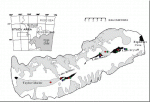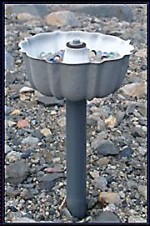The landscape of the McMurdo Dry Valleys (MCM) Long Term Ecological Research site is dominated by bare soils, perennially frozen lakes, ephemeral streams, and glaciers -- all of which harbor viable microbial communities. As a consequence of strong and persistent winds in the Dry Valleys, aeolian (airborne) transport is believed to be the main process responsible for redistribution of microorganisms throughout the MCM landscape. Freeze-dried microbial mats found in stream and on lake ice surface, sediments on the glacier and lake ice surfaces as well as soils can all readily be dispersed by wind over great distances. Studies have shown that microbial assemblages inhabiting lake ice are very similar to those found in sediments on glacier surfaces, which would imply airborne transport of microorganisms between the lakes and the glaciers.
To study the role of wind on the distribution of microorganisms in the MCM, we deployed a series of aeolian traps at nine locations within the Taylor Valley, our primary site of research in the MCM (Fig. 1).
The traps consist of bundt pans placed in three transects, perpendicular to the south shore of each of the three lakes (Fryxell, Hoare and Bonney). Additional traps are deployed on the permanent ice cover of each lake and on the top of major glaciers. Each pan is mounted approximately 30 cm off the ground on a PVC post and contain a layer of marbles to create a boundary layer so that airborne particles are more likely to be deposited, and once deposited, they are less likely to be blown away (Fig 2). Material from the bundt pans is collected annually and is analyzed for various physical, chemical and biological properties. The traps have proved effective in collecting a wide range of soil particles and organisms ranging from nematodes to bacteria.
The airborne material found in the sediment traps has similar physical and chemical characteristics as nearby soils-slightly alkaline with very coarse texture and very low water, organic matter and nutrient content. Both bacterial and cyanobacterial DNA have been successfully isolated from the sampled material. We are now able to calculate the flux of major nutrients as well as microorganisms that are transported throughout the Taylor Valley via wind.
Furthermore, to obtain temporal data on wind dispersion events, nine Sensit Model H11B particle counters (http://www.sensit.com/) were purchased and installed at each bundt pan site during the 2007 field season (Figure 3). The sensors were mounted to the stands of existing meteorological stations at 30 and 100 cm above the ground. When a particle impacts the sensor, a charge is produced by a crystal within the sensor; one pulse represents a fixed amount of kinetic energy. This response has empirically been found to correlate significantly to mass flux by several independent researchers. The sensors are, therefore, giving us information about the amount and size of particles that are transported at each locality.
Hence, data from the H11B particle counters can be used, in concert with the bundt pan collections and meteorological network, to determine the timing, direction, and magnitude of significant particle movement throughout the Taylor Valley.
Preliminary data indicates that material in the Taylor Valley is predominantly transported near the soil surface. Most sediment is transported from South South West and South West (from the Antarctic continent toward the McMurdo Sound) and a little bit from the North East (from the ocean inland). This is happening during katabatic events when the wind speed is well above 10 meters per second.
Marie Sabacka is associated with the Priscu Research Group, Department of Land Resources and Environmental Sciences at Montana State University, Bozeman, MT

 Enlarge this image
Enlarge this image

